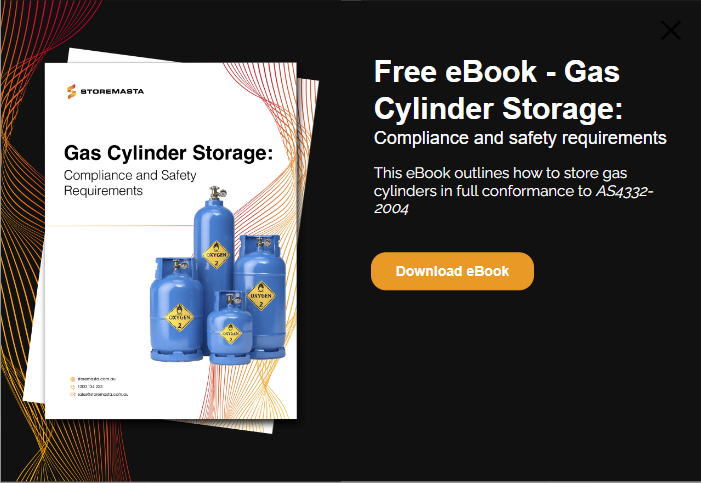Pure oxygen and acetylene are both gases used for a wide range of industrial welding and cutting applications. They are frequently stored at the same worksite, and both are extremely volatile and dangerously reactive. This blog looks at the risks and hazards associated with acetylene and oxygen gases (particularly when they are stored together) and outlines the requirements under AS 4332 - The storage and handling of gases in cylinders for storing them safely.
Acetylene and oxygen gases identified
Acetylene is an extremely volatile gas and never used in a pure state. The gas contained in the maroon cylinders seen at workplaces and mining sites all over Australia is a mix of gas, a solvent (usually acetone) and a porous mass which serves to slow down dangerous reactions like decomposition. Acetylene is a Class 2.1- Flammable Gas, can react dangerously with oxidising agents and may explode if heated.
Pure oxygen gas is usually supplied in black cylinders and comes in a range of purities: industrial grade, food grade, ultra high purity, dry breathing extra high pressure etc. Please note: food grade oxygen used at wineries often comes in grey cylinders. Oxygen is a Class 2.2/5.1 non-flammable, oxidising gas and may cause or intensify a fire, as well as explode if heated.
IMPORTANT: Never rely on colours alone to identify gases in cylinders, always check the labels and supporting Safety Data Sheets (SDSs).
Risks and hazards of acetylene and oxygen gases
Acetylene cylinders and oxygen cylinders both have their own unique risks and hazards, and MUST NEVER be stored together as they can react dangerously with one another. We look at both separately below.
Acetylene cylinders
Acetylene cylinders require special precautions and must be stored and handled with extreme care. The main risk associated with acetylene cylinders is a dangerous chemical reaction known as decomposition. Decomposition gives out a great deal of heat and can cause spontaneous fires and explosions. Some risks and hazards and include:
- Flashbacks from welding and cutting equipment causing decomposition and an explosion.
- Decomposition and explosions caused by cylinders exposed to heat from sunlight, hot works, industrial plant and machinery.
- Cylinders handled roughly or stored lying down causing the acetone and acetylene within the cylinders to separate and decompose.
- Acetylene will react with incompatible substances like copper, brass, silver and mercury.
- Dropped or roughly handled cylinders can heat from shock and friction resulting in a delayed explosion.
- Cylinder valves opened too quickly can create static electricity and solvent loss. Ultimately causing decomposition and an explosion.
Oxygen cylinders
Though pure oxygen on its own does not burn, it causes any combustible material it comes in contact with to burn much hotter and much faster. The main risk of oxygen cylinders is gas leaks creating an oxygen enriched atmosphere (oxygen levels are higher than 21%) where fires are easily ignited. Some of the risks and hazards associated with oxygen cylinders include:
- Leaking oxygen creating an oxygen enriched environment. Leaks can be caused by damaged hoses, worn and damaged valves, loose connections, leaving valves open when the cylinder isn’t being used.
- Oxygen cylinders contacting combustible substances like oil, grease, certain plastics and metals can create fires and explosions
- Workers incorrectly substituting oxygen for compressed air and others gases causing fires and fatal explosions
- Damaged or ruptured cylinders creating a fire or explosion. Cylinders damage can be caused by incorrect handling/storage (dropped or falling; impact from vehicles or falling objects)
- Cylinders exposed to heat can explode.
IMPORTANT: Free flowing acetylene, as well as O2 can create spontaneous fires and explosions
Storing acetylene and oxygen gases
All compressed gas cylinders must be stored according to the strict guidelines of AS 4332 - The storage and handling of gases in cylinders. Gas bottles must be stored:
- At ground level
- Upright with valves closed and cylinder caps in place
- Securely restrained by individual safety straps or chains
- Protected from impact
- Preferably outside in a well ventilated area
- Inside a secure area that has been fenced off and unable to be accessed by unauthorised persons
- Away from any potential ignition sources including static electricity
- With mandatory placards and warning signage
- Near first aid equipment, SDSs, and emergency instructions
Section 4.4 of the Standard requires the segregation of incompatible gases from each other within a gas bottle cage. At the same time the store itself must be isolated (separated) from site boundaries; other Dangerous Goods stores; combustibles, refuse and vegetation; ignition sources; industrial heat (radiators, hotwork, steam pipes, furnaces); and openings to buildings.
Class 2.1 Flammable Gases (acetylene) and Class 2.2/5.1 non-flammable, oxidising gases must be segregated from each other within a gas cylinder storage cage by at least 3 meters. If this distance cannot be achieved, a barrier wall (at least 1 metre higher than the tallest cylinder) can be used to achieve the segregation. The wall must be made of non-combustible materials and impervious to the gases.
IMPORTANT: Gas cylinder stores need adequate ventilation to maintain safe oxygen levels and keep gases within explosive limits.
Storing oxygen and acetylene with compliance
If your workplace uses oxygen, acetylene and other compressed gases why not download our free eBook; Gas cylinder storage: Compliance and storage requirements. Read it to gain a full understanding of the risks and hazards of storing compressed gases in cylinders. This eBook will also show you how to identify and control the risks associated with gas cylinder in your own workplace. Download it today and control your gas risks.
Joining the team as a Dangerous Goods Storage Consultant, Melissa Hampton became Storemasta's Marketing Manager in late 2021. With extensive knowledge and experience in chemical compliance, Melissa is responsible for leading the Marketing team and helping shape their marketing strategy. In her spare time, you can find Melissa hiking, swimming and enjoying the great outdoors in beautiful north-west Tasmania.
